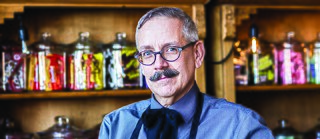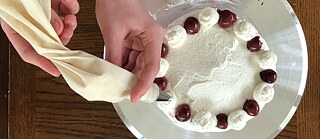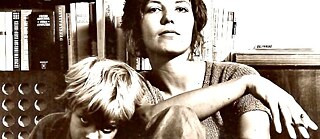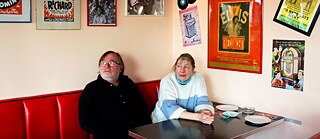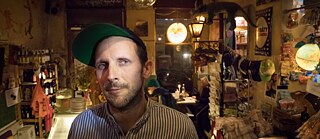Childhood Nostalgia
Candy
As a kid, candy makes the world go round. As an adult, it has the power to bring back long-forgotten childhood memories. Carol McKinley talks about the magic of candy with Tony Vallejos who ran a vintage sweet shop in Colorado.
Listen to this episode: Apple Music | Spotify | Download
This episode is from Carol McKinley, a journalist with over 40 years of experience. Carol lives in Colorado with her husband, her mom, and her French bulldog. She grew up in Wiesbaden, Germany, in the ’70s and says that German culture is still one of her greatest passions. In this episode, Carol and her interviewees recall their favorite treats growing up and the memories they associate with them. She also speaks at length with Tony Vallejos who owned a vintage candy store in Fort Collins, Colorado. In addition to this episode, Carol produced the story “Sacred Self.” The photo above shows Tony in his sweet shop and comes from Julia Vandenoever Photography.
Transcript
Carol McKinley: Every era has its heroes. Its music. Its tragedies. And, of course, its candy.
Carol McKinley: So what kind of candy do kids eat now?
Kid 1: Maybe like some Tootsie Pops, maybe?
Carol McKinley: Really? What about Sour Patch?
Kid 1: Oh yeah, a lot of Sour Patch.
Carol McKinley: If you had some money, allowance or whatever, what would you buy?
Kid 2: I would buy like Jolly Ranchers, and I don’t know what else though.
Carol McKinley: What’s your favorite kind?
Kid 1: I like the strawberry. Isn’t there strawberry? And I also like the orange one.
Carol McKinley: So when you get money ... Do you get an allowance?
Kid 1: Yeah, kind of.
Carol McKinley: What do spend you your money on?
Kid 1: Well, I usually save my money, but sometimes, we go to stores, and I like to get like cotton candy or like Jolly Ranchers.
Carol McKinley: How about you?
Kid 2: I usually like to get either Sour Patch Kids. Maybe Airheads, Starbursts, maybe like Twix, maybe? Like some candy bars, I think? And maybe Kit Kats.
Carol McKinley: What did you say? Your favorite is what?
Kid 3: Skittles and M&M’s!
Carol McKinley: Are those still candies kids eat?
Kid 3: Yes, a lot, a lot, a lot. Definitely. Yeah, yeah. They’re awesome
Kid 1: [SINGS] What would you do for a Kit Kat bar?
Kid 2: [SINGS] I have no idea! [GIGGLES]
Kid: How many licks does it take to get to the center of a Tootsie Roll Tootsie Pop? Let’s see! One, two ... [CHOMPS] Two!
[VOICES LISTING CANDIES: TOOTSIE ROLL,NECCO WAFERS, JUICY FRUITS, BUBBLE GUM CIGARETTES THAT BLOW SMOKE, WAX LIPS, CANDY DOTS, MARY JANES]
Carol McKinley: Candy might be the universal language everyone needs right now.
[SINGING THE SUGUS JINGLE]
Carol McKinley: And why else, all the way around the world, do we remember those ad songs, you know, the books and movies about sweets — except they make us smile? [MUSIC] Do you remember how E.T. was lured out of hiding by Elliott with that irresistible human bait: a trail of Reese’s Pieces? Sales exploded 65% right after the movie came out. And what about that cult classic Chitty Chitty Bang Bang? It’s remembered because of a candy called Toot Sweets, made by the widower with the cute little kids. The kids who set their own dad up with the beautiful, truly scrumptious, daughter of Lord Scrumptious, who owns the candy factory. The most famous candy movie — you can argue with me, but perhaps it’s ...
[SINGING VARIOUS CANDY JINGLES]
[VOICE LISTING GERMAN CANDIES: DUPLO, HANUTA, BRICKLE BIT, ÜBERRASCHUNGSEIER, THOSE ARE KINDER EGGS, LITERALLY SURPRISE EGGS, KUHBONBONS, THOSE ARE LITERALLY ‘COW BONBONS,’ SCHLECKMUSCHELN, LITERALLY ‘LICKING MUSSELS,’ KINDER SCHOKOLADE, LITERALLY KIDS’ CHOCOLATE, CHOCOLATE FOR KIDS]
[VOICES LISTING CANDIES: WOWEE WHISTLE; MALTED MILK BALL; I JUST WENT BLANK ... OKAY, WHAT ARE THESE ... NIK-L-NIPS]
Carol McKinley: Do you know what’s funny about candy and about your store and what you had in that store? It’s kind of a ... it connects everybody, I don’t know how you feel.
Tony Vallejos: Oh, it really does.
Carol McKinley: We’re all so divided right now in this country, but candy, if you put candy out there ...
Linda: Absolutely. And then, somebody will take their favorite and you go: Oh, you love those too? I love those too! And you might not have ever known the person. It does connect you for sure.
[VOICE LISTING CANDIES: MILKA, RAIDER VERSUS TWIX, MON CHÉRI, POM POMS,BIG HUNK, LIKE YOU, TONY, MILK DUD, CANDY CIGARETTES, REESE’S PIECES]
Tony Vallejos: They used to have bubble gum on a long rope. It was like 36 inches long, it was grape. It was like a rope of grape gum. It was horrible, but I loved it.
Carol McKinley: Tony Vallejos created and owned the Fort Collins Candy Store and Emporium. It was his lifetime dream. But it was forced to close in 2020, a victim of COVID. When the doors shut for good, Northern Colorado lost one of its happiest places.
Tony Vallejos: Sorry, you know, the store not being open. [CHOKES BACK TEARS] Do you really want to record that part? I know what the store meant to so many people. It wasn’t a candy store. It was an accidental thing. I built a candy store, yes, but when the candy store opened, and I brought in my toy collection, something else took over. When I opened the candy store, I didn’t know it was going to open up this thing — they’re called ‘feelings,’ you know?
Carol McKinley: Feelings ...
Tony Vallejos I mean pretty much everybody who I met here in the building, and I brought them upstairs, and I’d give them some candy, it will always end up that they’re going to tell me that whatever I just gave them reminded them of somebody in their family or an event in their life or something.
Carol McKinley: COVID was a setback to Colorado’s candy man, but Tony Vallejos has found that in order to save the candy store, he must be as flexible as Laffy Taffy. This summer, he moved hundreds of pieces of memorabilia he’d saved for 50 years, practically a lifetime, from the emporium into a space in his new apartment in a senior care facility, where he lives with and takes care of his mom. The space is a time machine just waiting for blastoff.
Carol McKinley: So, you’ve got your collection in storage.
Tony Vallejos: Mm-hmm.
Carol McKinley: And so what are the things that people really love when they came into your store and your museum and saw?
Tony Vallejos: Well, the thing that surprised me that I brought in was the Looney Tune collection. So, I have pretty much the entire collection of the Looney Tune collector glass that you would get from the drive-throughs.
Carol McKinley: I see them. They’re awesome. So they were free?
Tony Vallejos: Well no, you would pay. They came from Hardee’s, which is now Carl’s Jr.’s. They were 29 cents extra, and then, you get a free refill, and you would collect them all. And I have collected them all. And they come in, and it was surprising because I have all these really rare antiques and toys, but when people turned around and saw the Looney Tunes ... Because everybody had them. Everybody went to fast-food places and got a little glass. Not too many people had the Howdy Doody toys or the Roy Rogers toys, but they did have the Looney Tunes glasses.
Carol McKinley: And I see an Oscar Meyer Wiener.
Tony Vallejos: Yeah, there’s an Oscar Meyer Wiener bank. And there’s ... I collect anything that’s kind of food-related. So, I have like, you know, Tony the Tiger memorabilia, Big Boy, and Mr. Peanut. I was just kind of focused on iconic symbols of our past that people related to.
Carol McKinley: Those are the Funny Face Kool-Aid glasses!
Tony Vallejos: Yes, so that is the entire collection of Funny Face mugs. And you would send in ten cents back in the ’70s, they were competitive with Kool-Aid. You would send in ten cents.
Carol McKinley: I think I did that.
Tony Vallejos: Yeah, they would send you, and I personally got that orange guy.
Carol McKinley: Jolly Olly Orange!
Tony Vallejos: Yes, I still have the box with my name on it.
Carol McKinley: You do not!
Tony Vallejos: Yeah, I love it!
Carol McKinley: He was born a couple of generations too late, Tony the candy man, but he’s a bridge to the past for so many who are stunned at the scores of treasures he brought from his emporium, now arranged on endless shelves in a tiny room — on tables and tucked into corners. It’s a magical space. In an unlikely place.
Tony Vallejos: And when I closed down the store and even moved into my house, my apartment, when the management came upstairs — and she had heard that I had brought my collection upstairs — and she came in, she walked into the room. And I, as I’m explaining to her why the toys were there and why they were going to be going away soon — because it’s a lot, it’s a lot of toys in one space — and I turn around, and she’s got tears rolling down her face, and she said it’s just too much to take in.
Christy Haper: When I walked into that room it was just like, I just couldn’t. I was just taken back. So, I mean it was ... I was almost speechless really, but the tears just came almost instantly.
Tony Vallejos: Caught her off guard.
Christy Haper: It did.
Tony Vallejos: People said to me all the time, they said it’s overwhelming when they came to my store.
Christy Haper: It is just all the good. It’s just all the good. It really is. Just grandparents. Just the love. Everything. You can walk in, and it’s just like you’re instantly taken back to that time, and with them being gone so long ... You just don’t feel that anymore. I mean, you feel that sadness because they’re gone. It’s almost like you forget for a little while, and then, you see it. And it brings joy and just comfort really. It was kind of like a big hug for me.
Carol McKinley: I asked a woman named Susan Benjamin who is a candy historian. And yes, there is such a thing. What it is about an everyday thing like candy that cracks our ivory tower. That connects us to the point of bringing us to our knees.
Susan Benjamin: It’s so amazing how much candy means to people and part of the reason is that our grandparents and great-grandparents and aunts and people who loved us gave it to us. Also for many of us, we went and were able to make purchases when we were kids and have a big bag of penny candy. Or we’d have them at parties. So there are all of these really wonderful, fond memories. And probably the best of them would be the grandparents and great-grandparents, as I mentioned, who carried these candies in their purses and pockets and gave them to us because they loved us, and they wanted us to know. I started getting into historic candy because someone had asked me a question about candy in general. I’d always been a researcher of many things, including language and including mythology, and here I was asked about candy, and what I discovered was unbelievable. The most interesting and most salient aspects of what it is to have been in North America from the origins of sugars and sweets with the Native Americans to the present day.
Carol McKinley: So going way back, what was the first recorded sign that humans were gnawing on something for enjoyment. Are we talking 1700? You know, time of dawn? Like when did that first start?
Susan Benjamin: The first known chewing gum was actually about 9,000 years old and was found by researchers in Sweden. The irony of this chewing gum is that the teeth marks in it turned out to be those of a Neanderthal teenager. So, you just have to imagine his mother’s yelling at him and he’s chewing the gum, and he spits it out. But that was it. The first gum was made out of tree resin.
Carol McKinley: You said we love candy but we also hate it, Susan. What do you mean by that? How can you do both?
Susan Benjamin: Well, we love candy, and we use words like sweetheart and honey in a really dear kind of a way with people, and we wanna eat it, and we love candy when we eat it. But we also feel guilty because we think that it is bad for you. It doesn’t have any nutritional value. It adds calories and so on. So, it also is about fun. We love to work, and if we don’t love to work, we do it anyway, but we’re not quite there with having fun. Candy is fun.
Carol McKinley: Candy and music culture collided in 1964 when John Lennon and George Harrison publicly confessed to a Jelly Baby fetish. And then, they had to take cover when adoring fans decided that throwing them was a groovy idea. A reporter asked George about it on February 11, 1964.
Reporter: George, there’s been some remarks accredited to the Beatles that you aren’t too appreciative of all of the jelly beans being thrown at you on your tour.
George Harrison: No, it’s a bit dangerous, you know, ’cause a jelly bean traveling about 50 miles an hour through the air, and if it hits you in the eye, well, you’re finished, you know, you’re blind. We’ve never liked people throwing stuff. We don’t mind them throwing streamers, but jelly beans are a bit dangerous, you see.
Carol McKinley: Fast-forward to 55 years to a real-life movie theater on the ground floor of the Fort Collins Senior Living Center, where Tony has earned himself some new friends by showing old films and TV shows. And of course, giving out those sweets in fancy wrapping.
[“LEAVE IT TO BEAVER” PLAYS IN THE BACKGROUND]
Carol McKinley: Residents settle in with their dinner trays and open their purses and pockets to stuff the old-time candy inside. He scoops from a huge, sparkling, antique glass jar.
Linda: Hey, Tony Baloney! Where are my Necco Wafers? I’m waiting!
Tony Vallejos: Come on in. I set everything up over here, Linda.
Linda: Oh, you have my Napoleon [editor’s note: i.e., Neapolitan] coconut bars.
Tony Vallejos: Yeah, I gave one to Linda a while back ...
Linda: Those are my mom’s favorites, and he gave me one, and I just got so teary eyed. And he’s like: What’s wrong? And I said: That’s what my mama always ate. And it just brought back so many memories to me. It was incredible.
Tony Vallejos: And we were talking about this yesterday, and she started crying again. I felt so bad. She got so teary eyed just talking about that moment. And I had to give her a hug. And I felt like I’d done something terrible to her. And especially if they’ve passed, it really has a huge strength to that.
Linda: I was sharing eating this with my mom, you know. I really felt her presence just by having a piece of candy. It’s so weird. It’s hard to explain. And it’s emotional. She specifically liked the Napoleon ones, you know, with the different flavors and.
Carol McKinley: What are the flavors in it?
Linda: It’s strawberry, vanilla, and chocolate. Just like Napoleon ice cream.
Carol McKinley: What is it about how candy ... I mean, it’s just candy.
Linda: I know, but candies really invoke memories. They bring you back to a place and a time and even people that you’re with and your siblings. And yeah, it just brings back so many memories. It’s a great thing. Brings a smile to your face every time you have something or even see something. Like he’s got my other favorites here — Necco Wafers. Those are another super nostalgic thing for me ’cause we always ate Necco Wafers.
Tony Vallejos: They’re the oldest candy in America.
Linda: Are they really?
Tony Vallejos: These are from 1847 and from the NECCO, which means the New England Confectionary Company.
Carol McKinley: In church, like people would remember in church, their grandma would pull one of those out.
Linda: To keep them quiet.
Tony Vallejos: We played church when we were growing up. We played school, we played house, we played, well like, cowboys and Indians, and all kinds of stuff. And we would play church, and we were going to Sunday school. And as I’m telling you this, it sounds kind of weird, but we would give communion to each other.
Linda: Necco Wafers, there were five of us kids in the family, and we would always argue over who would get which color.
Tony Vallejos: Well, they all have flavors. Each one is individually flavored.
Carol McKinley: Do you remember how much they cost for the candies back then?
Linda: I think they were like a quarter for the whole thing. Very nostalgic too.
Susan Benjamin: Well, the Necco Wafer has long been used by grandmothers in church who have given it to their kids to keep them quiet, but also the flat Necco Wafer was used as a communion wafer. It wasn’t really one, but it was easy enough to give to a kid to figure out how to accept it, how to do it. Well, lo and behold, in the ’50s in Belgium, a communion wafer-maker, a real one, was having trouble selling his communion wafers, who knows why. But anyway, he got this idea — it’s the Cold War, and we have rockets going off, and we’re thinking of nuclear missiles, and we’re thinking about the Space Age and the moon. And he took two communion wafers, put them together, filled them up with sugar pieces, and they looked like a satellite, and that is the Satellite Wafer of today!
Carol McKinley: Are they still communion wafers? Are they still made out of that same ...
Susan Benjamin: There is something different with them, maybe a little bit more varied flavors than yesterday’s communion wafers, but people who eat them always comment that it reminds them of communion wafers without knowing the origin.
Carol McKinley: What are your memories of candy from when you were a kid?
Voice 1: Well, this is probably when I was in the third grade, and there was a tiny little drugstore at the end of the block just like the stereotype. And you’d get your quarter, and you would go in there, and you had things like wax lips, candy cigarettes, and so, you would just spread out that quarter the best you could over as many things as you could get.
Voice 2: When I was in fourth grade in Brookings, South Dakota, every Saturday we would go to the movies, and we’d have a cartoon and a movie and a short film, and it was like an all-day event to go to the movies. But next door to the movie theater was a candy store. So before we marched into the movie theater for the day, we went into the candy store, and they sold red rope licorice, and you could go in and get about 20 loops of red licorice for about ten or 15 cents, and that’s what I did every Saturday morning.
Voice 3: I will say that when I was about seven or eight, my grandfather would come sometimes for lunch, and we would see him coming up the walk. And we would be so excited because we knew that he would have handfuls of candy for us. And then, just as I would get excited, I would say, oh no, lunch is gonna be chicken livers because that’s what he loved.
Carol McKinley: What is that?
Linda: Those candy necklaces!
Carol McKinley: Well, they got kind of gross because you’d eat them, and then, you’d get spit on them.
Linda: And you’d get sticky on your clothes and your neck. But they were also, you know, it brings back childhood.
Carol McKinley: Do you have tears now?
Linda: I do! I get very emotional over it because, you know, part of my family is gone now and blah, I’m gonna cry, so, huh!
Judy: My name is Judy, and I grew up on the East Coast in a very, very liberal environment. I now live in the West, where they mountain climbed and biked and all that. We lived on a corner with a corner store. And in that corner store, we had penny candy, and I’m telling you that was the highlight of our day.
Carol McKinley: What was it called?
Judy: Wright’s. W-R-I-G-H-T-S. When I first moved there, they had sawdust back in the meat department, which we thought was great, but we were really only there for the penny candy, and I have to admit when we were really loaded, we had a penny for a pretzel stick, which you would stick your hand in this bin, and once in a while, we took two instead of one.
Carol McKinley: When you look at this candy, which one hits you?
Judy: Actually, I have to admit: the cigarettes. My mother and father smoked Pall Mall. My job almost every day was to go get two packs. I guess it was one pack because they would give me a quarter and two pennies for the tax.
Carol McKinley: Oh, you actually went and bought the cigarettes as a little kid?
Judy: Oh yes!
Linda: They knew what your parents smoked, and they knew all the families.
Judy: They didn’t care where I was. They never asked me a thing.
Carol McKinley: And you would bring those cigarettes home, so seeing those candy cigarettes ...
Judy: So, I wanted to do what they wanted to do. So when we went home, we gave the real
cigarettes. My mom would give us a couple of pennies for doing that. We went home and got our own cigarettes!
[SOUND OF JAR OPENING, SCOOPING OUT CANDY]
Linda: [SINGS] Kool-Aid tastes great. Wish we had some. Can’t wait!
Tony Vallejos: This kind of conversation we’re having right now happened in my store every day. I went home every day just worn out. But happy because so many people came in told me these stories and sang these songs.
[MUSIC]
Carol McKinley: Tony isn’t the only business person who has figured out that candy can reach somebody emotionally.
Carol McKinley: The name of this place is Niky’s or Nike’s?
Kim Machemehl: Niky’s our son and so the logo, the picture, is his face.
Carol McKinley: In historic Crested Butte, Colorado, the shelves at Kim Machemehl’s store, it’s called Niky’s Donuts, are lined with mouthwatering favorites.
Kim Machemehl: Like the candy buttons, I remember my grandmother having that in her purse, the candy buttons.
Carol McKinley: Cracker Jacks, yes.
Kim Machemehl: Cracker Jacks. Yeah. Even the swirly lollipops, that was the thing back then. Up there, those Wild West, I don’t know if they were called that back then, but people come in and they remember those big giant lollipops when they go to fairs and stuff.
Carol McKinley: I remember those.
Kim Machemehl: Then, Satellite Wafers. I don’t know what those are, but everyone who’s older grabs those.
Carol McKinley: Satellite Wafers! I’ve never even heard of those, but I’m from a different era. What do the little kids eat now?
Kim Machemehl: Anything gummy. We have the Moon Pies, too. So, oh we have moon pies, too. And the kids are like: What is a Moon Pie? And so we say: You’re gonna get one, and you’re gonna try it.
Carol McKinley: Why did you come in the store?
Customer: Oh, my kids came here the other night, and they had doughnuts and milkshakes, and they absolutely loved them, so they said they were the best milkshakes they’ve ever had.
Carol McKinley: Really? Uh-huh. Do you remember any of these from when you were growing up?
Customer: Oh yeah. My sister-in-law was just talking about that. Which ones?
Sister-in-law: The Bit-O-Honey!
Carol McKinley: What do you remember about that?
Sister-in-law: Chewing, like losing cavities.
Carol McKinley: But it’s so good, right?
Sister-in-law: Absolutely. Worth it. Totally worth it.
[SOUNDS OF NIKY’S DONUTS IN THE BACKGROUND]
Carol McKinley: And how about you? What do you remember about growing up?
Customer: The Sugar Babies are good. And the little bottles. I can still remember the taste of that wax with the sugary syrup that’s inside that I would never give my kids now. [LAUGHS] And then, I love that my son loves Smarties, and he just left, so I miss him. And these Wacky Wafers. They just remind me of playing softball in New Jersey. And these necklaces it’s like all this little sugary stuff. Yep, we love it.
Carol McKinley: You played softball? What did you have those after the game or ...
Customer: Yes, that and Bottle Caps and Wacky Wafers and Charms. We loved the Charms.
Carol McKinley: I don’t know what it is about candy that makes you feel good, right?
Customer: Well, it brings back your childhood. It makes it fun.
Carol McKinley: There’s one candy that unites Americans to Germany and that’s Gummi bears. But Americans don’t call them Gummis, do they?
Tony Vallejos: No, when they came into my store I had some American gummy bears, and then I had a German Gummi bear. I always thought that I was kind of mean.
Carol McKinley: Snobby?
Tony Vallejos: I was trying to educate them, and so, I would tell them there’s a difference between a ‘gummy bear’ and a ‘Gummi bear.’ And then, I would say, so if you want the Gummi bear, you’re going to have to learn that they’re called Gummi bears, and I told them what the translation of Gummi was, and why they call them Gummi bears and where they came from, and they really were open to learning about that. What I loved about it is that these little kids came in and they would run to the counter and say: We want to buy some Gummi bears! And I felt like I am kind of making a point here.
Carol McKinley: You’re making a difference in the candy world.
Tony Vallejos: I was just trying to make sure these kids knew there was a difference. There is a huge difference.
Carol McKinley: What’s the difference?
Tony Vallejos: Uh flavor, texture, all of the above. You open the bag, it smells different, it feels different.
Carol McKinley: Smells different? Really?
Tony Vallejos: Yeah, you can smell. The German Gummi bears, there’s more of a tropical flavor to them all. There’s something aromatic about them, and I can taste the texture, and then, maybe there’s a slight sourness to them.
Voice: We moved from the United States over to Wiesbaden, Germany, for five years. And one of the first things I discovered over in Wiesbaden was German Gummi candy, and specifically, there’s Gummi bears, but I loved the Gummi Cokes. The little tiny Coca-Cola bottle-shaped candies. And they were perfect. You’d get little tiny bags, they might have ten or maybe 15 Gummi cokes in them. And they were like treasure to us. I loved them. I had them all five years while I was there. And then, I came back to the United States, and they’re just not the same. They’re not even close.
Carol McKinley: Why is that?
Voice: Who knows? I don’t understand it, but they don’t taste the same. They don’t have the same texture. They don’t have the same smell.
Carol McKinley: Not even the same smell.
Voice: No, they had a great Coca-Cola smell over in Germany, and they don’t have that here. So, all I can say is: American kids are missing out.
[VOICE LISTING GERMAN CANDIES: MILKY WAY, EVERY FRIDAY, LIEBESPERLEN NONPAREILS, LITERALLY LOVE PEARLS, PEARLS OF LOVE, PEZ DISPENSER WITHOUT FEET, MARZIPAN KARTOFFELN, LITERALLY MARZIPAN POTATOES]
[VOICES LISTING CANDIES: CHOCOLATE, ALL CHOCOLATE, SWEETARTS, SUGAR CANDY ... WHAT DO THEY CALL THOSE? CANDY STICKS? ROCK CANDY? ROCK CANDY, THANK YOU. CHOCOLATE-COVERED CHERRIES FOR MY MOM. THOSE LITTLE CORDIAL CHERRIES AT CHRISTMAS TIME? WITH THE LITTLE JUICE INSIDE OF THEM? I LOVED THEM. IS THAT WHAT YOU’RE TALKING ABOUT? THEY ONLY CAME OUT AT CHRISTMASTIME.]
Carol McKinley: So, see what happens? You just start talking about memories. You stop naming the ...
Judy: I’m going to start to cry just hearing some of this. I’m walking into Tony’s room, he’s storing them for his store and to see my childhood in front of me, still alive. Those Hopalong Cassidy mugs. And all the things I grew up with, all my favorite. I’d eat cereal, I hated to get a mug. I just love that that man came into my life. We’re in a tough environment now. None of us here are young. We are all trying to live together. But candy? And all the good things from our childhood and our life with our parents have come alive through Tony. And if anybody, anywhere should have a public store where everyone can enjoy that feeling, call me. I’ll talk to you.
Tony Vallejos: You’re my hero. I love you so much, you guys. Thanks. I want to fight to get the store open. I really do. I fight every day for it.
[SINGING “THE OOMPA LOOMPA SONG”]
Linda: [SINGING] The Kool-Aid kids are off again to visit other lands. Be sure to join them when they do. Join them in some Kool-Aid too!!!!
Carol McKinley: For THE BIG PONDER, with Editor Markie Lindemulder, I’m Carol McKinley.



